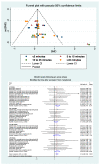Ghrelin as a Biomarker of Stress: A Systematic Review and Meta-Analysis
- PMID: 33673594
- PMCID: PMC7997253
- DOI: 10.3390/nu13030784
Ghrelin as a Biomarker of Stress: A Systematic Review and Meta-Analysis
Abstract
Introduction: Ghrelin is an orexigenic hormone which favors food-seeking behavior and has been postulated to be a biomarker of stress. We conducted a systematic review and meta-analysis on the evolution of ghrelin levels following acute stress.
Methods: The PubMed, Cochrane Library, Embase, and ScienceDirect databases were searched for studies reporting ghrelin levels before and after acute stress in humans.
Results: We included ten studies for a total of 348 patients. Acute stress (intervention) was always in a laboratory. Acute stress was psychological (Trier Social Stress Test), physical, or mixed (cold pressure test). The overall meta-analysis demonstrated an increase in ghrelin after the stress intervention (ES = 0.21, 95CI 0.09 to 0.34) compared with baseline levels. Stratification by time demonstrated an acute increase in ghrelin levels in the five minutes immediately following the initiation of stress (0.29, 0.10 to 0.48) but without any difference after. Obese individuals had a more significant (ES = 0.51, 95CI 0.18 to 0.84) and prolonged increase in ghrelin levels for up to 45 min compared with non-obese individuals who had a significant increase only five minutes after stress. Moreover, the ghrelin levels increased in response to stress with BMI (coefficient 0.028, 0.01 to 0.49; p = 0.013) and decreased with the time after the stress intervention (coefficient -0.007, -0.014 to -0.001; p = 0.025).
Conclusion: Ghrelin is a biomarker of stress, with a short-term increase following acute stress. Obese individuals have both a higher and prolonged response, emphasizing the link between obesity and stress.
Keywords: anxiety; appetite; mental health; metabolism; public health.
Conflict of interest statement
The authors declare no conflict of interest.
Figures







References
-
- Buzgoova K., Balagova L., Marko M., Kapsdorfer D., Riecansky I., Jezova D. Higher perceived stress is associated with lower cortisol concentrations but higher salivary interleukin-1beta in socially evaluated cold pressor test. Stress. 2020;23:248–255. doi: 10.1080/10253890.2019.1660872. - DOI - PubMed
Publication types
MeSH terms
Substances
LinkOut - more resources
Full Text Sources
Other Literature Sources
Medical

